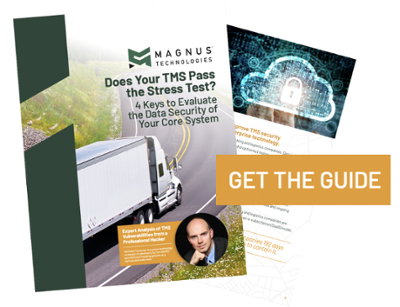Why Cloud-Based TMS Systems Offer Better Cybersecurity
One of many reasons to deploy a modern, cloud-based transportation management software (TMS) system is to have instant access to an ecosystem of third-party integrations. The software-as-a-service (SaaS) model helps companies of all sizes take advantage of new technology faster than ever before.
Does greater connectivity from SaaS-based TMS have a downside? Is it fair to assume that more connections with third-party applications increase the number of potential threats when compared to using a more traditional, on-premise TMS?
With cyberattacks on the rise, relying on past assumptions may be putting you at greater risk. According to cybertalk.org, ransomware attacks on the transportation industry went up 186% between June 2020 and June 2021.
Better Protection Against Cyberattacks?
Trucking and logistics companies are seeking out the best tools and strategies to fortify their defenses. The cybersecurity benefits of using a SaaS-based TMS versus a traditional, client-server model rest on four main pillars.
Physical Security: Traditional, client-server models are housed at company locations, often in a server room that may or may not be locked or have restricted card access or surveillance systems. SaaS-based TMS platforms are run by cloud computing service providers who are experts on running a secure operation and follow strict protocols for physical access to servers. Many are certified for meeting data security compliance rules like HIPAA, Payment Card Industry Data Security Standard, SOC 2, SOX, ISO and GDPR.
Leading cloud-computing providers like Microsoft Azure or Amazon Web Services (AWS) adhere to standards for physical access that are “far better than what a trucking company could do,” said Nick Crown, chief operations officer of Magnus Technologies.
IP Security: Most cyberattacks are not committed by people who have physical access to servers. Perpetrators usually start by accessing your domain through user accounts. They will send phishing emails, steal passwords or make other backdoor entries into your network. Once they log into your system they will continue to penetrate additional security layers until they get what they want.
Intrusions through user accounts can be hard to trace and even tougher to contain. According to Trend Micro, 91% of all cyberattacks start with a spear-phishing email.
An enterprise SaaS-based TMS is best able to protect against these types of cyberattacks by using advanced protocols and encryption techniques. These protocols are the same ones you use for online banking and establish a secure channel of communications between the system and web browsers of authorized users. Secure protocols to access cloud-based TMS systems include Transport Layer Security (https) and Secure Socket Layer (SSL).
Additionally, the SaaS model can be protected by multiple firewalls and sequestered in a “security arena” that can only be accessed by secure protocols. By comparison, an on-premise server may be protected by an internet firewall but is likely surrounded by computer systems or IoT devices like workstations, tablets or mobile devices running on the same network. This vulnerability makes it easier for attackers to gain access to the network by targeting specific individuals (spear phishing).
Network Visibility: Organizations must not only have visibility of all traffic running on or through their networks but also quickly identify exceptions before the damage is done. This is a tall order. The average time it takes for transportation companies to detect a breach is 192 days and then another 60 days to contain it, according to research by IBM. And the financial and reputational fallout from a breach is massive. According to Cybercrime Magazine, it cost companies around the world $6 trillion to fix breaches in 2021.
An enterprise, SaaS-based TMS has the advantage of vendors and their cloud computing service providers monitoring IP traffic and deploying security patches and software updates. Many use advanced SIEM (security information event management) systems that can detect intrusions and breaches the instant they occur to contain the threat.
Business Continuity: No matter how secure a TMS is, companies must also prevent downtime from other possible scenarios like natural disasters or server crashes. Business continuity is a top-of-mind concern when evaluating TMS options. On average, the cost of downtime for vehicle repairs, accidents, system failures/outages, etc., costs fleets $448 to $760 per vehicle per day. The cost is much greater when businesses lose access to data that prevents them from dispatching drivers or billing customers.
A speedy disaster recovery can save a company tens of thousands of dollars or more per day, depending on the size of the fleet.
Transportation companies that use a SaaS-based TMS have data backups included as part of the package, from the main server to one or more servers in different locations. If something happens to the main server, all of your data and services can switch to the backup server seamlessly.
If an on-premise server crashes, it could take minutes, hours or even days to get it back up and running. Restoring an on-premises server with backed up data could put you behind by a day or more. The speed and frequency of data backup and recovery provided by a cloud-based TMS is difficult to beat.
The SaaS Advantage
Besides the security and business continuity benefits of a SaaS-based TMS, companies also get the advantages of low upfront costs, scalability and continuous updates. All these benefits give IT staff time to focus on more important business functions than server maintenance. Cloud-based models work equally as well for large enterprises as they do for small and midsize businesses.
The Magnus TMS is an enterprise, SaaS-based platform that delivers a complete, end-to-end dispatch and order fulfillment solution for truckload and LTL fleets. The TMS provides business continuity and data security by being backed up in five-minute increments, and can immediately switch to a different computing environment with full data recovery within minutes.
Be sure to get your copy of “Does Your TMS Pass the Stress Test?” to get more information about the advantages of SaaS vs. client-server TMS models with expert analysis by a professional hacker.

